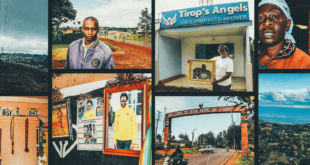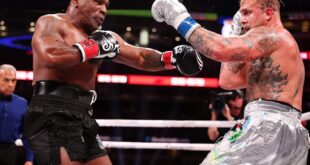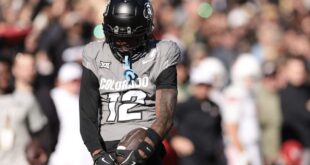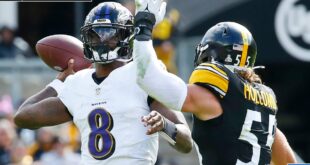Stay informed on all the biggest stories in Formula One. Sign up here to receive the Prime Tire newsletter in your inbox every Monday and Friday.
Buddy Boren was circling a good idea.
Early in 1983, the lifelong Dallas resident called his friend, Dallas construction owner Larry Waldrop. They met at Arthur’s, an upscale steakhouse near Park Cities, one of Dallas-Fort Worth’s wealthiest enclaves. Oil paintings, dark wood, clinking glass — it was the ideal place for business associates to meet and figure out how to fund a wild idea.
Or, in Waldrop’s case, to encourage a wilder one. Boren, who grew up working on cars and drag racing, wanted Waldrop to invest in a documentary he might produce about Carroll Shelby, a Dallas racer and track designer.
Waldrop urged him to dream bigger.
“I said, ‘Buddy, you know, I’m really not interested because you know you can’t make money on a documentary,’” Waldrop said. “And this is where it gets really funny. I said, ‘Buddy, boy, if I’m going to invest (in) something, I want to do something like those cars that race over in Monte Carlo.
“That’s how naive I was at the time.”
It’s also how Formula One ended up with one of its most notorious races, one that looked more like “Mad Max” than Monaco, as drivers passed out from the Texas heat and financial misdeeds bubbled away in the background.
In an era of 24 races a year, when new cities have crowded onto the calendar, the 1984 Dallas GP, run 40 years ago this year, serves as a reminder that running even one weekend for the pinnacle of motorsport is no mean feat. It was a race that didn’t make it, falling somewhere between an ill-fated venture and a predictable disaster, depending on whom you ask.
The two culprits: the easily overlooked financial uncertainties of this world and the oppressive mid-summer Dallas weather.
“It’s a very sad situation,” track designer and promoter Chris Pook said of the race becoming a one-off. “It’s a great shame, a great shame.”
By 1984, those in Dallas’ high society must have felt their city was on the cusp of becoming an international destination. The early 80s saw an influx of computer and telecom companies move into the area and the construction of eight of the 10 tallest buildings in the city’s skyline. Dallas hosted the Republican National Convention in August 1984. And the soap opera “Dallas,” about a fictional oil-affluent Texas family, was a major hit even in Europe, where it cemented the idea of Dallas as the quintessential modern American city.
“You had this television show going on with J.R. Ewing that the Europeans were feeding on voraciously, as well as the American audience,” Pook said. “You still had the lingering (feeling) from 1963 with the Kennedy assassination, of this being the wild, wild west and everybody walking around in cowboy hats.”

The F1 world dressed the part during Dallas Grand Prix weekend. (Bernard Cahier / Getty Images)
This project would be expensive — $1 million to pave the 2.38-mile course and $1.5 million to install safety barriers, not to mention promotion in a city mostly unfamiliar with the European sport. After establishing Dallas Grand Prix, Inc., Waldrop and Boren were put in touch with Don Walker, a wealthy real estate developer and avid racing fan.
Walker owned an umbrella company that managed commercial and residential properties. He also operated Can-Am races in the United States and Canada. When he first met with Waldrop and Boren, Walker said he would put up all the money needed to get the race off the ground. “Little did I know where he got the money from,” Waldrop said. Boren had signed an agreement with Walker that, in essence, gave Walker complete control of the company — something he would later regret.
The group needed to convince the city and F1 to approve the race. By the 1980s, F1 occupied a place in the world’s imagination that was not dissimilar to today — an exclusive, wealthy sport with attractive drivers who raced in the world’s top destinations. Monaco, Montreal, Dijon — a city that allured F1 became understood as an alluring place to do business, visit, see and be seen.
And one thing Dallas had going for it in 1984: Many Europeans found it interesting. With an assist from Pook, the FIA and then-F1 CEO Bernie Ecclestone approved an F1 race in Dallas in 1984.
Even before approaching F1, Boren had to get approval from the city to race at Fair Park, a 277-acre area downtown that hosts the annual State Fair of Texas and houses Cotton Bowl stadium.
According to Waldrop, the manager of Fair Park at the time was hard to win over. “He thought we were crazy. But he was willing to talk with us. So I found his secret: He loved scotch.” Waldrop made a point to set meetings at 4 p.m. and set out a bottle of scotch on the table. “We got a little dizzy,” Waldrop recalls with a laugh.
The fairgrounds, a Texas landmark with streets winding through Art Deco architecture, museums, and livestock barns, would be a unique backdrop for an F1 race.
“Well, first of all, they got the Cotton Bowl sitting in it, right? It’s a historical place,” Pook said. “It’s got some interesting architecture to it. Even though there were horse and cow barns there, they’re interesting. And you run a race around all day with all that stuff as a backdrop? It creates its own life — it creates a Texas life. It’s the Texas message. It’s a Dallas message.”
It was up to Pook — who had experience starting a successful grand prix, conceiving and designing the Long Beach Grand Prix in 1975 — and his team back in California to create the track around Fair Park. They developed a complete engineering profile of the circuit and a construction plan for the safety equipment and calculated the degrees of each turn. The final design was a 2.424 mile (3.901 km) course that wound around the Cotton Bowl, between the Art Deco museums on avenues of the state fairgrounds. Concrete walls topped with chain-link fencing would line the entire track. Most corners were blind turns, and the track was very fast, thanks to multiple sweeping curves.

An essential factor for Boren, Walker, and Waldrop was the fan experience. They wanted the weekend to feel like the Texas version of the Monaco GP — a festival atmosphere with Texas flair and a broad enough appeal to attract as many spectators as possible. As popular as the Dallas Cowboys were then, the sports-hungry Metroplex was unfamiliar with Formula One.
Ads running in the Dallas Times Herald and Fort Worth Star-Telegram described the atmosphere of an F1 race in florid language: the race would be “unparalleled ecstasy” and “two hundred miles of sweet agony.”
The ad headline read, “An event you’ll always remember. A thrill you’ll never forget.”
The advertising even attracted Bobby Epstein, the future chairman of the Circuit of the Americas in Austin, Texas, home of the United States Grand Prix. At the time, Epstein was a teenager working at the Farmers’ Market. An avid racing fan and curiosity sufficiently piqued, he and his brother bought the cheapest tickets they could get.
“The Formula One world was totally behind us,” Waldrop said. “They made a mistake, though.”
Instead of April, as had been suggested, the FIA and F1 set the race date for July 8. July and August are generally the hottest months of the year in Dallas. In 1984, the average temperature in July was 84 degrees Fahrenheit (28.8 Celsius).
“Hotter than hell,” Walker said. Pook called it “hotter than Hades.”
Meanwhile, infighting had set in at Dallas Grand Prix, Inc. Four months before the race, Walker bought Boren out of the company, leaving Walker with two-thirds and Waldrop with one-third. The dispute delayed the track’s paving by about four months. The temporary asphalt was laid down about six or seven weeks before the race. Pook said that kind of asphalt needs three or four months and a full weather cycle to cure properly.
“With the intense heat of the weekend and the unbelievable torque that Formula One tires produce, that asphalt didn’t stand a chance,” Pook said.
When race week arrived, the world of F1 descended on Dallas. Away from the track, all seemed well. Drivers and their families attended a gala with most of the cast of “Dallas” at Southfork Ranch (the show’s setting). Former U.S. President Jimmy Carter and his wife, Rosalynn, showed up for the celebrity race on Saturday. (Driver Stirling Moss was reportedly awestruck about meeting a U.S. president.) Back in Europe, a French newspaper headline read, “Formula One goes to the Casa of J.R.!”
The event was a sell-out, with over 100,000 fans braving the weather and flocking to Fair Park over the weekend. But Epstein said he doesn’t remember a “festival” atmosphere around the race for casual fans, as you’d see at today’s F1 weekends or even this weekend’s U.S. Grand Prix. The race did seem to successfully court the high-society and gearhead types.
“If you go back and look at the Times Herald and the Star-Telegram, look at the society pages, the coverage of all these spectacular parties being put on in people’s homes in Highland Park,” Pook said. “Everybody trying to out-party their neighbor.”
According to Pook and Waldrop, F1 was pleased with the buzz. “It was just hot,” Pook said.

Drivers tried everything to stay cool. (Paul-Henri Cahier / Getty Images)
Cracks literally started to show as cars hit the track. The schedule was packed — seven different racing events happened on Saturday, with five more planned on Sunday around the two-hour F1 race. While drivers enjoyed the circuit’s speed, they complained about the lack of run-off areas and bumpy surfaces.
“It was a typical street circuit — a lot of concrete walls, not particularly fast,” Lotus-Renault driver Derek Warwick said. “A few places you could’ve overtaken and quite bumpy. Very bumpy, actually.”
The weekend heat averaged about 100 degrees Fahrenheit (37 degrees Celsius). Due to the heat and constant racing, the track began to disintegrate. Crews constantly had to repair it, and at one point, the drivers had to practice at six in the morning so the heat and cars wouldn’t damage the asphalt.
“Jacques Laffite, I remember, came to practice one morning in his pajamas,” Warwick said. “He thought that was very funny.”
Between the concrete walls, heat and decaying surface, some drivers considered boycotting the race entirely.
“A lot of the drivers didn’t want to do it, to be honest,” Warwick said. “People didn’t want to do it because of the heat. I don’t think anybody was prepared for the kinds of temperatures that were out there.”
In the end, the boycott dissipated. On race day, the start time was moved to 11 a.m. to mitigate the mid-afternoon heat. “It was a race of attrition,” Warwick said. He and teammate Nigel Mansell started on the front row.
Twenty-six drivers started the race, and, one by one, they fell out of it. Eddie Cheever spun out on Lap 8. Warwick lost control of the car trying to get around Mansell for the lead (he’s still mad at himself for it today). The heat wore out engines left and right. Tires melted away on the disintegrating track surface.
And the heat beat down on the drivers. Piercarlo Ghinzani’s crew dumped ice water on him during a pit stop. When Huub Rothengatter finished the race, he poured cold water down his pants to cool off. Mansell’s gearbox failed on the final lap — he tried to coax the car over the finish line but collapsed from exhaustion. (Ghinzani overtook him as marshalls rushed to assist.)
In the end, Keke Rosberg won. He had previously said drivers were complaining too much about the heat. According to the Star-Telegram, Rosberg had used a workaround: a special helmet featuring a rubber bladder filled with cold water — a design initially tested by NASA.
From fans to drivers, the consensus was that year one of the Dallas Grand Prix was a mess. Drivers seemed more upset with the track than the heat. On Saturday night, more new concrete was laid down to patch parts of the disintegrating track. Cheever said driving on the mix of new concrete and broken asphalt was worse than driving on a wet racetrack.
“You couldn’t really prepare yourself for the circuit,” Rosberg told the Star-Telegram.
The heat was front-and-center for the fans, who hunted for shaded areas around Fair Park all weekend. Epstein remembers the crowd thinning out as the race continued and the heat became unbearable.
“When it’s 100 degrees and sunny, even though they have great intentions of sitting in their seats, they don’t last long,” Epstein said. “Over the course of a couple of hours, it seemed like all the security and order sort of deteriorated to this survival game at some point.”
Despite the debacle, it looked like Dallas had a future in the sport. It had a three-year contract, and F1 and Ecclestone were good to honor it. A second year could’ve been focused on ironing out the problems. Recent F1 race additions have proven this, as the Miami GP and Las Vegas GP have worked to address concerns in Year Two. The Dallas GP’s most prominent problems seemed easy enough to rectify: Move the race date earlier in the year and ensure the paving gets done much earlier.
The fans had shown up, but if Epstein is any example, the promoters would have to work to get them to return.
“I’m not sure I would have bought a ticket had it come back the second year,” Epstein said. “I’m not sure anybody would have. Depends on the date, I guess.”
In the months after the race, Dallas Grand Prix, Inc. was beset by legal and financial troubles. Dallas City Council member Diane Ragsdale and the Dallas Black Chamber of Commerce filed a class-action lawsuit against Walker and the company for not consulting enough with the predominantly Black, low-income neighborhoods around Fair Park. This prevented Waldrop from negotiating an agreement on a 1985 date with F1. In the meantime, the FBI and SEC were investigating Waldrop for diverting company and real estate funds to his personal accounts.
In essence, investors had accused him of using their investment money to finance losing ventures. The Dallas Grand Prix, as a first-year event, was destined to be one of them.
“He thought, ‘OK, I’ll just take some of my investors’ money and put it in this race, and I’ll get it back on Monday morning afterward,’” Pook said. “Guess what? The first year costs eat you up.”
On March 15, 1985, Walker put Dallas Grand Prix, Inc. into bankruptcy.
“The event ceased there and then,” Pook says. “Nobody wanted to come in and rescue it because of all those ongoing investigations.”

Nelson Piquet drives in the Grand Prix of Dallas in Fair Park on July 8, 1984. (Paul-Henri Cahier / Getty Images)
The Dallas Grand Prix failed because it was a one-off. But Waldrop and Pook believe its successes and what it did for the city remain its legacy, further reinforcing the idea of Dallas as a modern city, shed of stereotypes.
“We were no longer the guys with straw in our teeth,” Waldrop said. “We were a metropolitan area. There’s no doubt in my mind that (the race) added to the image. You throw our race in with the TV series ‘Dallas,’ and Dallas became a metropolitan city with those two events.”
The other lasting legacy of the race is its impact on the modern U.S. GP at Circuit of the Americas in Austin. When Epstein helped close the long-term contract between COTA and F1 in 2010, he was adamant that the two not make the same mistake again.
“When I got involved, one of my first conversations with F1 and Bernie and everyone was, ‘We are not going to risk our money and do this in June,’” Epstein said. “And I think, in fact, it was slated for the end of June. So that was the only input I had towards everything, which was the calendar date on this thing is wrong. We’ve got to get a fall or spring date. And so we wound up slotted in the fall.”
Boren passed away in 2011. In interviews, Waldrop and Pook spoke of him fondly as the heart behind the event.
“The guy was the nicest,” Pook said. “He was the nicest guy you could ever meet. He was just a nice man with an idea. And a desire.”
As F1 continues to expand, courted by new cities worldwide, it’s a reminder of what comes with that kind of desire. It’s one thing to want to introduce your city to F1. It’s another to find the balance between sport and spectacle, to nail the logistics of running a race — practical, political and financial. These tensions still exist 40 years later.
And getting it right the first time is everything.
“If your audience is 15 to 19 years old and they’re teenaged like we were, it’s one thing to go out when it’s 100 (degrees out),” Epstein said. “But to ask people who have a lot of choices in life to come back, and they melt one year? It’s hard to get them to come back.”
(Top photo: Paul-Henri Cahier / Getty Images; Design: Eamonn Dalton / The Athletic; Graphics: Drew Jordan / The Athletic)
Source link
 meganwoolsey Home
meganwoolsey Home



